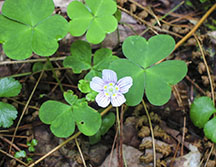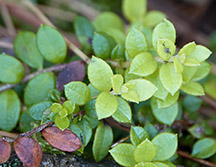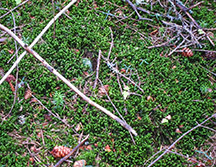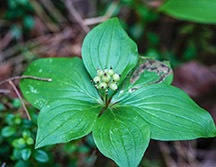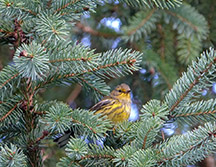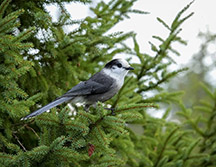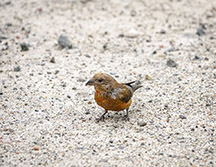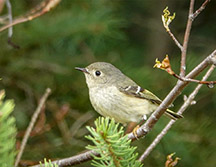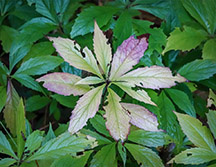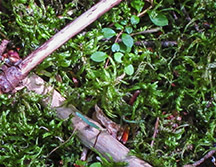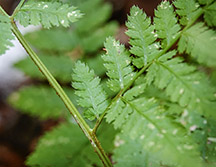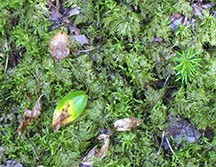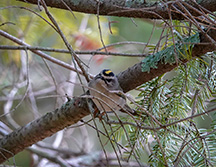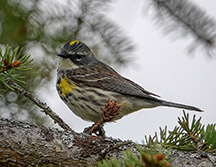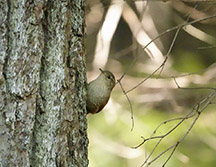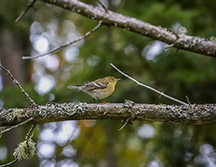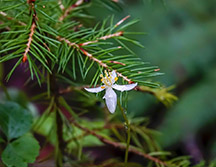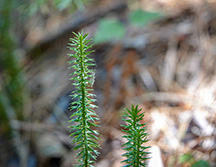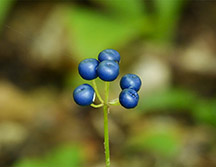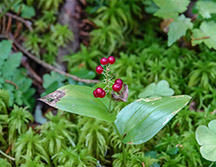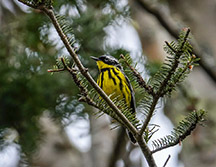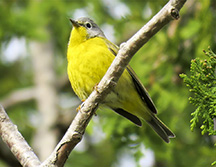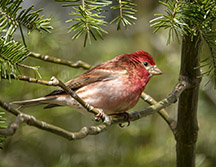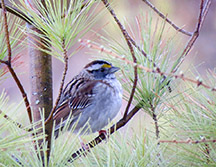Conifer Forests in the Adirondacks
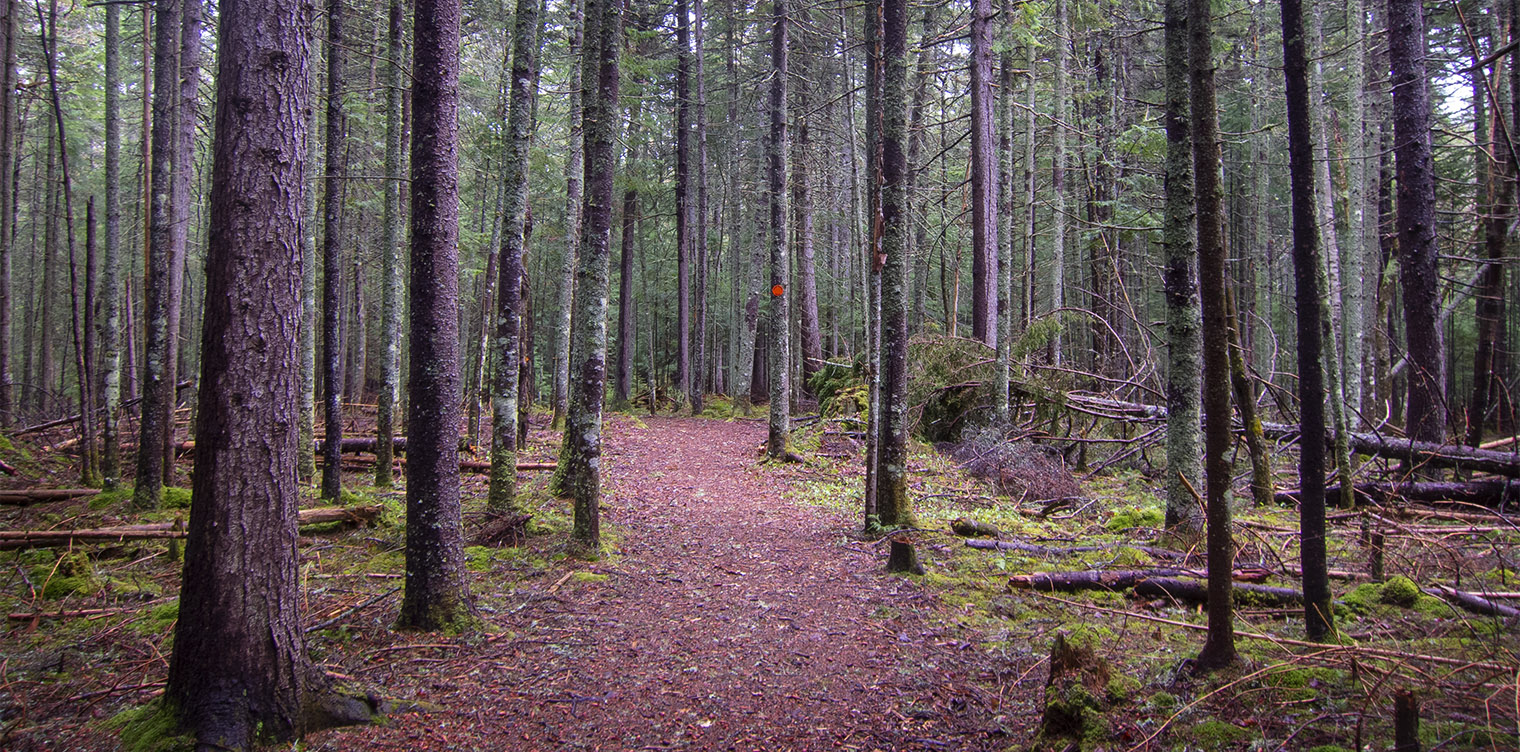
The Adirondack Park hosts different types of conifer forests. Lowland conifer forests are found in imperfectly drained flats, low ridges, and knolls. Mountain conifer forests are generally found at elevations above 2800-3000 feet on steep mountain slopes. Conifer forests in the Adirondacks include several ecological communities:
Adirondack Conifers
Adirondack conifer forests are dominated by two conifer species: Red Spruce and Balsam Fir. Both species are found in other ecological communities in the Adirondack Park, including mixed forests and wetlands.
- Red Spruce (Picea rubens) is a medium-sized evergreen conifer that grows in cool, boreal forests of the northeast, including the Adirondack Mountains. It is the conifer species most typical of the Adirondack region as a whole. Early records suggest that the Red Spruce constituted a quarter of the forest cover in the northern Adirondacks at one time. This species is very high on the scale of shade tolerance and can grow in a variety of soils. It is generally considered a climax species.
- Balsam Fir (Abies balsamea) is a medium-sized conifer and the species most typical of the Adirondack high country. It is shade tolerant and flourishes in both well-drained and poorly drained soils. In undisturbed forests of the High Peaks region, Balsam Fir shared dominance with Red Spruce, with Red Spruce dominating the lower levels of the spruce-fir belt and Balsam Fir dominating at higher elevations to the timberline.
Balsam Flats
Plants & Birds of the Balsam Flats Ecological Community
The balsam flats ecological community is a low-elevation conifer forest that is found on low flats near swampland and on low ridges and knolls within swamps. This community is limited to the northern part of New York State and is concentrated in the central Adirondacks. It is generally found at elevations up to 2000 feet. The dominant tree in this community is Balsam Fir, which grows in pure stands or in mixed stands with Red Spruce or Black Spruce. There may be a few Eastern White Pine, Northern White Cedar, Eastern Hemlock, Yellow Birch, or Red Maple specimens.
- As with other conifer forests in our area, the shrub layer is sparse, and consists primarily of seedlings of the principal tree species, but may also include Hobblebush or Northern Wild Raisin.
- The forest floor is dominated by mosses such as Stair-step Moss, liverworts like Bazzania, and shade-loving ferns such as Spinulose Wood Fern, Intermediate Wood Fern, and Northern Lady Fern. It is usually covered by a deep mat of fir and spruce needles.
- Wildflowers that flourish in this ecological community include Common Wood Sorrel, Creeping Snowberry, Clintonia, Bunchberry, Wild Sarsaparilla, Goldthread, and Dewdrop.
- Birds associated with the balsam flats ecological community include Blackburnian Warbler, Ruby-crowned Kinglet, Spruce Grouse, Swainson's Thrush, Yellow-bellied Flycatcher, Yellow-rumped Warbler, Bay-breasted Warbler, Black-backed Woodpecker, Boreal Chickadee, Cape May Warbler, Canada Jay, Olive-sided Flycatcher, Red Crossbill, American Three-toed Woodpecker, and White-throated Sparrow.
- Mammals found in this community include Fisher, Moose, Snowshoe Hare, White-tailed Deer, Porcupine, Red Fox, Red Squirrel, Deer Mouse, and Southern Red-backed Vole.
Mountain Spruce-Fir Forest
Plants & Birds of the Mountain Spruce-Fir Forest Ecological Community
The mountain spruce-fir forest is a mountain conifer forest community occurring on cool upper slopes at elevations between 3,000 and 4,000 feet, above spruce-northern hardwood forests and below mountain fir forests. Most sites are somewhat protected from prevailing westerly winds. This forest has a closed canopy dominated by Red Spruce and Balsam Fir. Subcanopy trees are usually found at low density including Mountain Ash, Mountain Maple, Pin Cherry, and Striped Maple.
- The shrub layer is made up mainly of seedlings and saplings of canopy trees. Other shrubs found in sites disturbed by landslides or fire include Red Elderberry, Mountain Holly, and American Fly Honeysuckle.
- The forest floor is usually carpeted with a dense layer of moss, including Sphagnum, Schreber's Big Red Stem Moss, and Stair-step Moss. Lichens hang from the trees.
- Characteristic ferns and fern allies include Mountain Wood Fern.
- Characteristic wildflowers include Common Wood Sorrel, Clintonia, Canada Mayflower, Bunchberry, Whorled Wood Aster, and Goldthread.
- Characteristic birds in this ecological community include White-throated Sparrow, Blackburnian Warbler, Canada Jay, Spruce Grouse, Cape May Warbler, Winter Wren, Golden-crowned Kinglet, Yellow-rumped Warbler, Blackpoll Warbler, Swainson's Thrush, Yellow-bellied Flycatcher, and the rare Bicknell’s Thrush.
- Characteristic mammals include Snowshoe Hare, American Marten, Red Squirrel, Northern Flying Squirrel, Porcupine, and Deer Mouse.
Mountain Fir Forest
Plants & Birds of the Mountain Fir Forest Ecological Community
Mountain fir forests are conifer forests that occur on thin, acidic soil on cool upper slopes, above mountain spruce-fir forests and below alpine krummholz communities. Mountain fir forests are restricted to high-elevation slopes of the Adirondacks and Catskills, at elevations from 3,500 to 4,500 feet.
- The tree layer is almost entirely composed of Balsam Fir, with occasional specimens of Red Spruce and American Mountain Ash.
- As with other conifer forests, the shrub layer is made up mainly of seedlings and saplings of the dominant tree species, in this case Balsam Fir.
- The forest floor hosts a carpet of mosses, including Schreber's Big Red Stem Moss.
- Ferns found in this community include Mountain Wood Fern and Intermediate Wood Fern. Common Bristly Clubmoss and Shining Clubmoss is also found here.
- Characteristic wildflowers include Common Wood Sorrel, Clintonia, Canada Mayflower, Bunchberry, Whorled Wood Aster, and Goldthread.
- Characteristic birds include White-throated Sparrow, Winter Wren, Blackpoll Warbler, Yellow-bellied Flycatcher, Magnolia Warbler, Purple Finch, Nashville Warbler, and (in limited cases) the Bicknell's Thrush.
In some areas, these forests display alternating bands of trees in sequential stages of development called fir waves. Fir waves are a pattern or forest regeneration sometimes described as wave-regeneration. The forest appears patchy with crescent-shaped bands of dead trees interspersed with large areas of green canopy. This pattern is due to wind disturbance.
- When a tree succumbs to wind, a gap in the canopy is formed, exposing trees on the leeward edge to greater wind.
- As these leeward trees die, the gap gradually expands downward, while young trees begin growing in the windward portion of the gap.
The mortality wave advances through the forest following the direction of the prevailing winds, at a pace between one and three meters per year.
References
New York State Department of Environmental Conservation. New York Natural Heritage Program. Ecological Communities of New York State. Second Edition (March 2014), pp. 122-124. Retrieved 17 January 2017.
New York Natural Heritage Program. 2022. Online Conservation Guide for Balsam Flats. Retrieved 29 March 2022.
New York Natural Heritage Program. 2022. Online Conservation Guide for Mountain Fir Forest. Retrieved 29 March 2022.
New York Natural Heritage Program. 2022. Online Conservation Guide for Mountain Spruce-Fir Forest. Retrieved 29 March 2022.
The Nature Conservancy. Acadian Low Elevation Spruce-Fir-Hardwood Forest. Retrieved 20 December 2019.
The Nature Conservancy. Acadian-Appalachian Montane Spruce-Fir-Hardwood Forest. Retrieved 20 December 2019.
State University of New York. College of Environmental Science and Forestry. Adirondack Forest Communities. Retrieved 22 December 2019.
The Cornell Lab of Ornithology. Birds of North America. Subscription web site. Blackpoll Warbler, Canada Jay, Cape May Warbler, Golden-crowned Kinglet, Magnolia Warbler, Nashville Warbler, Purple Finch, Red Crossbill, Ruby-crowned Kinglet, White-throated Sparrow, Winter Wren, Yellow-rumped Warbler. Retrieved 21 December 2019.
Kevin J. McGowan and Kimberley Corwin (Eds). The Second Atlas of Breeding Birds in New York State (Cornell University Press, 2008), pp. 378-379, 424-425, 430-431, 432-433, 476-477, 484-485, 486-487, 490-491, 506-507, 570-571, 608-609, 612-613.
Donald J. Leopold and Lytton John Musselman. Wildflowers of the Adirondacks (Johns Hopkins University Press, 2020), pp.26-27, 36-38.
Donald J. Leopold, Carol Reschke, and Daniel S. Smith, "Old-Growth Forests of Adirondack Park, New York," Natural Areas Journal, Volume 8, Number 3 (July 1988), pp. 166-189. Retrieved 21 December 2019.
Douglas G. Sprugel, "Dynamic Structure of Wave-Regenerated Abies Balsamea Forests in the North- Eastern United States," Journal of Ecology, Volume 64, Number 3 (November 1976), pp. 889-911. Retrieved 24 December 2019.
Charles C. Adams, et. al., “Plants and Animals of Mount Marcy, New York, Part II,” Ecology, Volume 1, Number 3 (July 1920), pp. 204-233. Retrieved 2 October 2019.
Nancy G. Slack and Allison W. Bell. Adirondack Alpine Summits. An Ecological Field Guide (Adirondack Mountain Club, 2006).
E. H. Ketchledge. Forests and Trees of the Adirondack High Peaks Region (Adirondack Mountain Club, 1967).
John Kricher. A Field Guide to Eastern Forests. North America (Boston: Houghton Mifflin, 1998). Retrieved 21 December 2019.
Peter J. Marchand. Nature Guide to the Northern Forest. Exploring the Ecology of the Forests of New York, New Hampshire, Vermont, and Maine (Appalachian Mountain Club, 2010).

